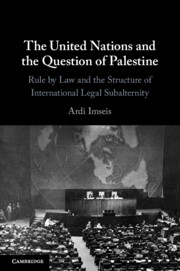 The United Nations and the Question of Palestine
The United Nations and the Question of Palestine Published online by Cambridge University Press: 16 November 2023
Under international law, occupation is meant to be temporary and occupying powers cannot be sovereign in the territory they occupy. In contrast, since 1967 Israel has systematically altered the status of the OPT with the aim of annexing it, de facto or de jure. During this time, though the UN has focused on documenting the legality of a range of individual violations of international law by the occupying power, scant attention has been paid by the Organization to the legality of the occupation regime as a whole. Emphasis has instead been placed on encouraging the parties to bring the occupation to an end through continued, though widely discredited, bilateral negotiations. By what rationale can it be said that Israels occupation remains either legal or legitimate in the absence of good faith on its part in negotiating the occupation’s end? How can its end reasonably be made contingent on negotiations between occupier and occupied? This chapter argues that the UN’s failure to take a more principled position on the very legality of Israel’s half-century ‘temporary’ occupation of the self-determination unit of the Palestinian people is demonstrative of the maintenance of Palestine’s legal subalternity in the UN system, under a different guise.
To save this book to your Kindle, first ensure [email protected] is added to your Approved Personal Document E-mail List under your Personal Document Settings on the Manage Your Content and Devices page of your Amazon account. Then enter the ‘name’ part of your Kindle email address below. Find out more about saving to your Kindle.
Note you can select to save to either the @free.kindle.com or @kindle.com variations. ‘@free.kindle.com’ emails are free but can only be saved to your device when it is connected to wi-fi. ‘@kindle.com’ emails can be delivered even when you are not connected to wi-fi, but note that service fees apply.
Find out more about the Kindle Personal Document Service.
To save content items to your account, please confirm that you agree to abide by our usage policies. If this is the first time you use this feature, you will be asked to authorise Cambridge Core to connect with your account. Find out more about saving content to Dropbox.
To save content items to your account, please confirm that you agree to abide by our usage policies. If this is the first time you use this feature, you will be asked to authorise Cambridge Core to connect with your account. Find out more about saving content to Google Drive.